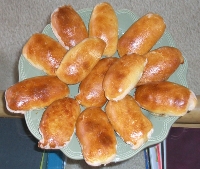Пирожки

Today I'd like to write about пирожки (singular пирожок), a word maybe as famous as матрёшка ![]() , although the former belongs to the food category and is not a souvenir as the latter. Russian cuisine is famous for its doughy things, and пирожки are among them. Basically, it is dough with filling inside. The filling can be anything: berries, mushrooms, roots, vegetables… anything you wish to put in there. The dough is not a simple dough, however, but a little complicated to make, and it takes time to master the skill of preparing it. In Russian it is called сдобное тесто. Recipes vary, but the thing they all have in common is that they have yeast, and and the dough takes time to rise. Many great Russian authors, e.g. Tolstoy, Dostoevsky, Chekhov, Paustovsky, and Turgenev, numerous times mention in their writings the process of making the dough for pirozhki (or for bliny, like Сhehov, who wrote a special short story about it, «О бренности»; see «Как испечь блины по-чеховски?» for details
, although the former belongs to the food category and is not a souvenir as the latter. Russian cuisine is famous for its doughy things, and пирожки are among them. Basically, it is dough with filling inside. The filling can be anything: berries, mushrooms, roots, vegetables… anything you wish to put in there. The dough is not a simple dough, however, but a little complicated to make, and it takes time to master the skill of preparing it. In Russian it is called сдобное тесто. Recipes vary, but the thing they all have in common is that they have yeast, and and the dough takes time to rise. Many great Russian authors, e.g. Tolstoy, Dostoevsky, Chekhov, Paustovsky, and Turgenev, numerous times mention in their writings the process of making the dough for pirozhki (or for bliny, like Сhehov, who wrote a special short story about it, «О бренности»; see «Как испечь блины по-чеховски?» for details ![]() . K. Paustovsky in his autobiographical novel «Повесть о жизни/Розовые олеандры» discusses the making of куличи (a type of пирожки for Easter), and he calls the process of preparing the dough священнодействием а sacred act:
. K. Paustovsky in his autobiographical novel «Повесть о жизни/Розовые олеандры» discusses the making of куличи (a type of пирожки for Easter), and he calls the process of preparing the dough священнодействием а sacred act:
| После уборки происходило священнодействие — | After straightening up, the sacred act took place — |
| бабушка делала тесто для куличей… | Grandma made the dough for kulichi… |
| Кадку с жёлтым пузырчатым тестом укутывали ватными одеялами, | The vat with the yellow bubbly dough was covered with cotton blankets, |
| и пока тесто не всходило, нельзя было бегать по комнатам, хлопать дверьми и громко разговаривать. | and until the dough rose, we weren't allowed to run through the rooms or slam the doors or talk loudly. |
| Когда по улице проезжал извозчик, бабушка очень пугалась: | Whenever a drayman passed along the street, Grandma would get really nervous: |
| от малейшего сотрясения тесто могло «сесть», и тогда прощай высокие ноздреватые куличи, пахнущие шафраном и покрытые сахарной глазурью! | the smallest vibration could make the dough fall, and then it would be goodbye to the tall, spongy kulichi, redolent of saffron and covered with sugary glaze. |
I myself remember the same kind of feistiness over making dough for kulichi. Maybe it is because kulichi are for Easter, and because of the religious connotation, extra care was needed. Usually for regular pirozhki it is much less demanding! Kulichi don't have a filling; they are made in oval molds and have raisins inside. Pirozhki have the filling, as I mentionned above, and here each chooses each own! My all time favorites are two kinds: pirozhki with eggs and green onions, and pirozhki with apples. One has to boil a few eggs, and then finely chop them with green onions, and add salt and pepper. For the kind with apples I stew finely chopped applles with water and sugar for about forty minutes, making sure they stay moist, adding water if necessary, and then put them in pirozhki. The last trick (but not the least!): do not forget to baste your pirozhki with egg (beat one egg with a whisk for basting) before baking, it will add such glamour to your pirozhki that they will be hard to resist, just like in that picture! Actually, the pirozhki in the picture I made myself for a party at my house, they turned out very delicious, and everyone liked them!
Good luck with making your own pirozhki, and
ПРИЯТНОГО АППЕТИТА ! ![]() BON APPETIT !
BON APPETIT !
2 comments
Great article.
I have been researching Russian culture to try and understand a co-worker a little better. This helped understand one of her favorite foods growing up.
Thank you
you mean, bon appetit! (it’s masculine!). nice blog, very informative. personally, i prefer слойки over пирожки.
Thanks for the correction! It’s been fixed on the main entry.
Form is loading...